Abstract
The origin of liposuction can be traced to an adverse event by Dujarrier in 1921 when he used a uterine curette to remove fat from the knees of a ballerina ending in an amputation secondary to damage of the femoral artery. The history of liposuction since then has been one of avoiding complications and optimising outcome. After this adverse event, liposuction was abandoned until the 1960's when Schrudde revived the practice using small stab incisions and sharp curettage with the secondary suction to aspirate the freed tissue. This technique was associated with a high incidence of complications especially seroma and skin necrosis. Illouz then replaced the curette with a blunt cannula connected to vacuum pump thus avoiding the complications of a sharp curette. Despite the presence of various techniques for liposuction, suction assisted liposuction (SAL) is still the standard technique of liposuction. This article aims to discuss literature regarding the various aspects of liposuction (SAL) and to highlight the salient points in the literature and in the senior author's experience in order to avoid unfavourable outcomes in liposuction. A literature review on avoiding complication is in liposuction including some of the seminal papers on liposuction. Liposuction is generally a safe procedure with reproducible outcome. Just like any surgical procedure it should be treated with the utmost care. Illouz published 10 commandments for liposuction in 1989 and we review these commandments to demonstrate how liposuction has evolved.
KEY WORDS: Complications, liposuction, suction assisted liposuction
INTRODUCTION
Suction assisted liposuction (SAL) is the standard technique of liposuction. There are various other types of liposuction such as ultrasound-assisted liposuction, power-assisted liposuction (PAL), water assisted liposuction and laser-assisted liposuction.
In the absence of properly conducted trials comparing the various techniques, it is perhaps best to regard these techniques as an extension to SAL rather than a replacement.[1] This article aims to focus on conventional SAL and avoiding unfavourable outcomes in SAL.
HISTORICAL BACKGROUND
The origin of liposuction can be traced to an adverse event by Dujarrier in 1921 when he used a uterine curette to remove fat from the knees of a ballerina ending in an amputation secondary to damage of the femoral artery.[2] The history of liposuction since then has been one of avoiding complications and optimising outcome.
After this adverse event, liposuction was abandoned until the 1960's when Schrudde revived the practice using small stab incisions and sharp curettage with the secondary suction to aspirate the freed tissue. This technique was associated with a high incidence of complications, especially seroma and skin necrosis.[3]
Illouz then replaced the curette with a blunt cannula connected to vacuum pump thus avoiding the complications of a sharp curette.[4] The vacuum pump used by Illouz was standardised by Hetter who demonstrated the importance of adequate suction pressures.[5]
In the late 1980's, tumescent technique was developed by Klein resulting in decreased blood loss in liposuction and allowing the procedure to be performed without the need for general anaesthesia in certain cases.[6]
Until the 1990's, liposuction was traditionally performed in the deep subcutaneous layer only. This was changed by Gasparotti who popularised superficial liposuction using smaller cannulas,[7] which were originally developed by Teimourian.[8]
Matarasso is credited for demonstrating the importance of anatomic site as a factor influencing the outcome of liposuction and describing the safe zones of liposuction in the abdomen in combination with abdominoplasty.[9]
TECHNIQUES OF LIPOSUCTION ACCORDING TO INFILTRATE
There are four techniques of liposuction according to infiltrate: Dry, wet, super wet and tumescent. The dry technique involves no infiltration; the wet technique infiltrates 200-300 cc/area while the super-wet technique aims to infiltrate 1 ml/1 ml of aspirate. The tumescent aims to infiltrate 2-3 ml/1 ml of aspirate.[10]
The dry and wet are now regarded as historical because of the high estimated blood loss as a percentage of volume (dry 20-45% and wet 4-30%). Super wet and tumescent have a much lower blood loss as a percentage of volume (1%) and thus regarded as having a safer profile.[10]
The limitation with the above classification is that it relies on the pre-operative assessment of the amount of aspirate, which can be arbitrary. The classification of liposuction according to infiltrate is perhaps a more faithful classification when applied retrospectively after the surgery. Therefore, we believe that clinically the adequacy of infiltration can be confirmed by the fountain sign, which appears when the infiltration cannula is withdrawn and some of the infiltration fluid escapes. Adequate infiltration is also associated with firm tissue turgor, peau d’orange appearance and blanching of the overlying skin.[11] It is also important to ensure that the infiltrate is actually left in for 10 min to achieve its analgesic and haemostatic benefits prior to commencing liposuction [Figure 1].
Figure 1.
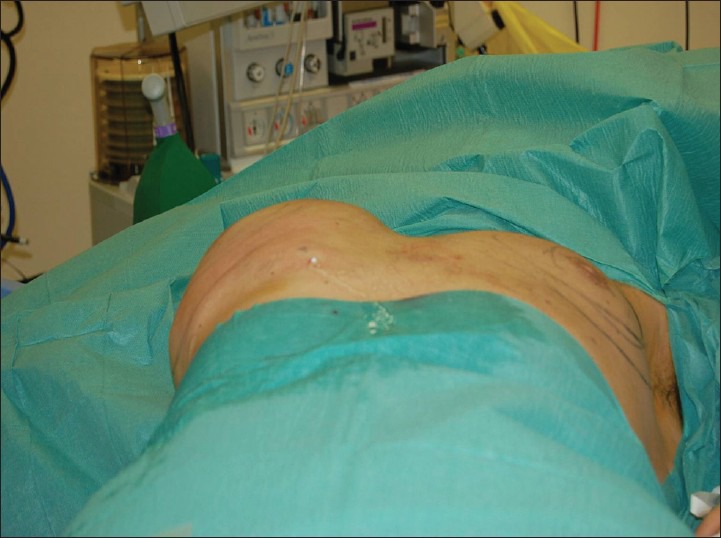
Tumescence in gynaecomastia
There is no consensus on the composition of the infiltrate as it may contain lidocaine, epinephrine and/or sodium bicarbonate depending on the surgeon's preference. The Practice Advisory on liposuction released by the American Society of Plastic Surgeons (ASPS) acknowledges the presence of different compositions of infiltrates provided that lidocaine is limited to the safe dose of 35 mg/kg unless the patient has low protein or other medical conditions where the metabolic by products of lidocaine breakdown may reach problematic levels.[12]
Tumescent liposuction has various surgical and anaesthetic advantages, but it is prudent to consider the possible complications of fluid overload such as pulmonary oedema, especially if the patient is having intravenous fluids simultaneously.[13]
PHYSICS OF LIPOSUCTION
In 1984, Courtiss highlighted the importance of applying Poiseuille's Law to liposuction:
ΔP = 8 μLQ/πr4[14]
Where ΔP is the pressure, L is the distance between fat and vacuum source including the length of flexible tubing connecting the pump to the cannula, μ is the dynamic viscosity, Q is the flow rate and r is the radius.
The application of this law was demonstrated by Rodriguez and Condé-Green in 2012[15] when they studied the negative pressures generated by syringes. They showed that a 60 cc syringe can reach a maximum negative pressure of −718 mmHg. This proves that the negative pressure generated by a syringe is no less than that produced by a machine and could in fact be higher. This should be borne in mind by the surgeon as using syringe liposuction would still require the same careful handling of tissues and gentle controlled movements as other types of liposuction.
We also believe that syringe liposuction gives more stable and over all pressure compared with many PAL techniques, with the added advantage of being able to reinject fat if the surgeon inadvertently overcorrects the area.
PRE-TUNNELLING AND CROSS TUNNELLING
We believe that one of the most important aspects of liposuction is pre-tunnelling. This is the step of creating tunnels within the fat using the liposuction cannula after the infiltration and prior to suction. Regardless the type of liposuction used, this step has to be done manually without assistance. Thorough and accurate pre-tunnelling ensures that subsequent liposuction will be in the proper plane and the precise desired location. Performing pre-tunnelling also ensures that the infiltrate has adequate time to start its analgesic and haemostatic effect. Unfortunately, despite its importance, pre-tunnelling is still sometimes overlooked by many plastic surgeons and is sometimes regarded as “not absolutely necessary but recommended if the fat is hard”.[16]
The senior author strongly believes in pre-tunnelling, for instance in an area with an aspirate of 500 cc, the infiltration of 750 cc would take 5 min, pre-tunnelling 20 min and liposuction of 500 cc would take 10 min. If pre-tunnelling is performed correctly, fat comes out effortlessly through the adits regardless the type of liposuction.
Cross tunnelling – via multiple adits- is also essential in avoiding unfavourable outcomes in liposuction. It allows for smooth and even adipoaspiration leading to a more controlled and pleasing outcome.
PRE-OPERATIVE ASSESSMENT
Proper patient selection is essential in patients seeking liposuction. The operating surgeon needs to obtain thorough medical history including body mass index (BMI), diet, life-style, exercise, medication history, quality of skin and smoking. A commonly overlooked aspect is skeletal deformity (e.g., of the spine), which can result in apparent asymmetry. Acquiring pre-operative photographs is also an important aspect of the pre-operative assessment. It is also important to discuss the limitations of liposuction and that it cannot be used as a panacea for all contour deformities.
Assessment of patients’ expectations is also essential to ensure they have realistic and achievable expectations. Patients need to understand that there is a racial variation in the deposition of fat, which is even observed in children.[17] Another study by Lim et al. 2011[18] demonstrated that Asian women have greater abdominal and visceral adiposity than Caucasian women with similar BMI.
On the other hand, the surgeon needs to understand the patient's perception of beauty and whether the patient prefers the more curvaceous appearance or the slim appearance. A recent study by Chithambo and Huey in 2013[19] demonstrated that there is also racial difference in the perception of beauty with some races having no relationship between BMI and perceived attractiveness. This is in contrast to white races where a negative relationship existed between BMI and attractiveness. In patients with slim figures, it is important to know whether they are pursuing abdominal etching.
Rohrich et al.[10] suggest the following outlines for examination: (1) Deviation from the ideal male or female aesthetic contour or silhouette. (2) Presence of asymmetries. (3) Presence of dimpling or cellulite. (4) Location of fat deposits (liposuction areas) and zones of adherence (non-liposuction areas).
In addition, there are specific examinations for certain areas. For example, there is a classification for gluteal liposuction suggested by Shaer:[20] (1) Lateral gluteal recess, (2) Anterior superior iliac spine accumulation, (3) Trochanteric accumulation, (4) Ptotic or large buttocks, (5) Diffuse lipomatous collection across upper buttocks, (6) Upper medial thigh fat collection, (7) Lower medial thigh fat collection.
LIPOSUCTION AS AN ADJUNCT
Liposuction in the abdomen can be done on its own or as an adjunct to abdominoplasty. Assessment for abdominal liposuction should include assessment for hernias, previous surgeries, scars and diverication of the recti. If the surgeon is unsure about the presence of hernias by clinical examination, it is warranted to investigate with an ultrasound scan. Matarasso's classification[9,21] can be a useful aid in the decision making in the recontouring of the abdomen. The use of liposuction as an adjunct can help decrease dog ears and optimise the contour.
In cases of gynaecomastia, it is important to rule out any underlying cause. Assessment needs to differentiate between fatty tissue, which is amenable to liposuction and fibrous tissue which requires excision. Again liposuction can be used on its own or as an adjunct to surgery. We find that performing liposuction in gynaecomastia prior to excision makes haemostasis and developing the plane easier.
Neck liposuction can be used as a definitive procedure or as an adjunct to face lift. This is one of the difficult areas to treat with liposuction and the ideal patient has good skin tone and elasticity, moderate submental fat, mild jowl formation and a high-set hyoid bone.
BMI AND LIPOSUCTION
An ideal candidate for liposuction would be of stable weight within normal BMI, exercises regularly and presenting with localised deposits of diet stubborn fat. These patients, however, are few and far between as many patients present to the plastic surgeon with the aim of utilising liposuction as a way to lose weight and improve body contour at the same time. It is very important for the surgeon to explain to patients with a high BMI that liposuction is an adjunct not a replacement to weight loss.
The current recommendation is for the patient to be within 30% of the ideal BMI,[22] but whether liposuction can be a contributing factor to weight loss is an area of controversy. There are studies showing that dermolipectomy leads to improved insulin sensitivity and weight loss;[23] on the other hand, there are more recent studies demonstrating that liposuction leads to a compensatory increase of visceral fat which can have more negative impact on patients’ health on the long-term.[24]
It is always a conundrum for the plastic surgeon when met with a patient with high BMI requesting multiple areas of liposuction as it is unclear whether these patients are going to gain or lose weight. This highlights the importance of a thorough consent process where the surgeon ensures that a patient with a high BMI understands and accepts the higher risks of complications and also accepts the fact that weight change can lead to contour irregularities.
LARGE VOLUME LIPOSUCTION
Another area of controversy is the maximum safe volume of aspirate. Large volume liposuction is defined as the removal of 5000 cc or more of total aspirate in a single procedure. The practice advisory on liposuction released by the ASPS[12] acknowledges that there is no scientific data available to support a specific volume maximum at which point liposuction is no longer safe; with that said it is important for the surgeon and patient to know that the risk of complications is unavoidably higher as the volume of aspirate and the number of anatomic sites treated increase. Therefore, the senior author does not usually aspirate more than 5L/session as we believe it is safer to perform large volume aspiration in multiple procedures thus allowing the patient to recover in between procedures. These controversies invite for more research to help settle these issues about liposuction.
Although in selected patients, the senior author might aspirate up to 5L, large volume liposuction cannot be a replacement for weight loss as demonstrated by Mohammed et al. 2008[25] who studied the long-term effects of large volume liposuction on metabolic risk factors. They demonstrated that despite a long-term reduction in subcutaneous fat, the metabolic risk factors did not improve.
OPERATIVE CAVEATS
It is important to mark the patients standing up as this demonstrates the effect of gravity. Markings should take into consideration the site of the incisions and the importance of having adequate access points for cross tunnelling. The surgeon should supervise the positioning of the patient ensuring that the patient's body temperature is well-maintained throughout the procedure and that adequate thrmoboprophylaxis measures are in place.
We tend to restrict the use of superficial liposuction. Sites favourable to superficial liposuction according to Matarasso are either areas with flaccid skin or areas with cellulite. Areas with flaccid skin are posterior neck, jowls, dosal back rolls, outer thighs, banana roll, abdomen flanks, lumbar roll, breasts, inner thighs and arms (least) while areas with cellulite are outer thighs, anterior thighs and buttocks.[9,21]
There are certain areas where the surgeon needs to exercise extra caution on liposuction especially the gluteal region. The area described by Fournier[16] as the “Bermuda Triangle” is a V-shaped area with the base at the level of the infragluteal crease and the apex at the lumbo-sacral junction. This area should be totally avoided in deep liposuction, even superficial liposuction should be done carefully by an experienced surgeon. Suctioning below the gluteal crease may lead to “double banana roll”.
Another area that warrants caution in gluteal liposuction is Gasparotti's point, which lies just posterior to the greater trochanter and depressions in this location result from aggressive suctioning of the deep fat.[7] Abduction and internal rotation of the leg are useful to drop the greater trochanter out of the surgical field and thus protect against a Gasparotti point depression. Gasparotti's point is one of the areas of controversy in liposuction as it seems to be a vaguely defined point and the senior author believes that various plastic surgeons would have various definitions for Gasparotti's point.
The surgeon also needs to exercise caution during liposuction from lower legs and ankle as it can lead to the undesirable outcome cosmetically if not done carefully and could lead to injury of underlying structures.
During the liposuction, it is important that the surgeon uses his other hand to continually receive tactile feedback and to confirm being in the right plane of liposuction. The surgeon should also continually assess for the adequacy of liposuction using the skin pinch test between thumb and index.
We also recommend feathering at the end of the procedure to be performed using smaller cannulas to give the area a nice and gentle curve rather than a sharp step [Figures 2–7].
Figure 2.
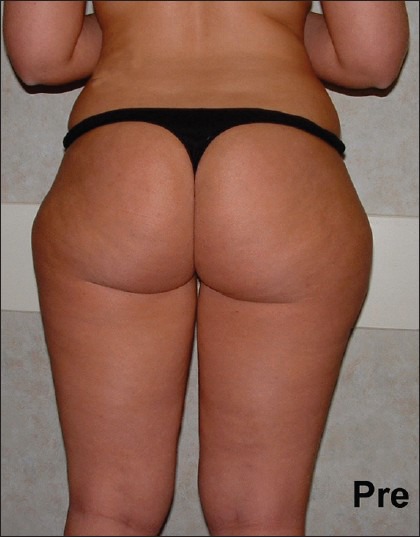
Pre-gluteal liposuction patient 1
Figure 7.
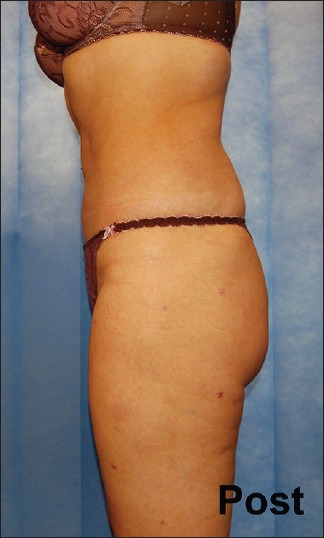
Post-liposuction patient 2
Figure 3.
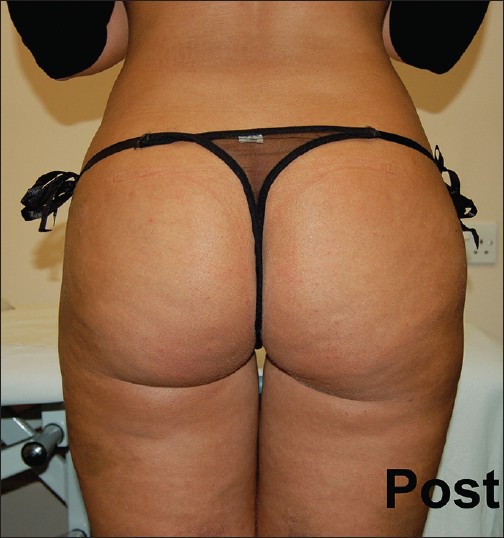
Post-gluteal liposuction patient 1
Figure 4.
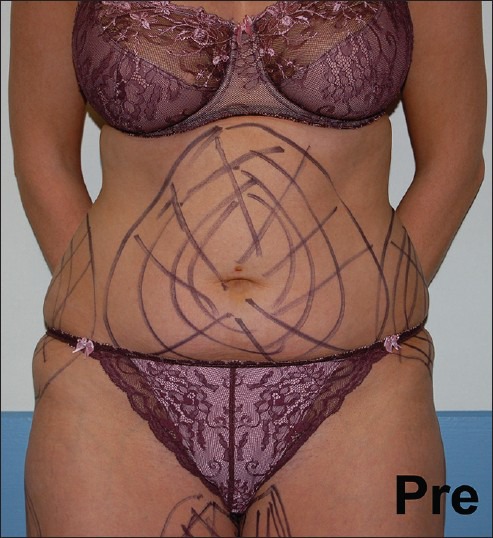
Pre-liposuction patient 2
Figure 5.
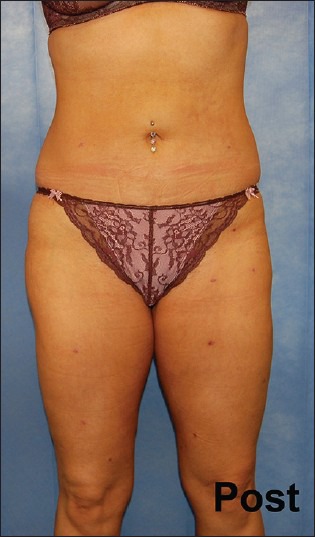
Post-liposuction patient 2
Figure 6.
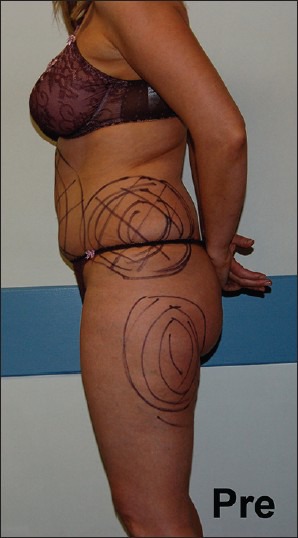
Pre-liposuction patient 2
SKIN RETRACTION
One of the problems of liposuction that can lead to undesirable outcomes is its apparent simplicity which can lure a novice plastic surgeon to overlook the importance of experience in achieving good results. Skin retraction assessment is an area where there is no alternative for experience. We always inform our patients that part of the outcome of liposuction will be dictated by the ability of their skin to re drape and retract over the new contour. One of the major drawbacks of liposuction is its ability to thin, but not tighten. Reliance upon skin retraction to affect a proper outcome will only lead to disappointment and this patient may instead benefit from an excisional-type procedure.[26]
COMPLICATIONS OF LIPOSUCTION
Liposuction is currently the most performed aesthetic plastic surgery world-wide; just such as any surgical procedure, it stands its own risks and complications such as contour irregularities, infection, hypoesthesia, oedema, ecchymosis, seroma, haematoma, skin discolouration especially at the site of adits and more serious complications such as pulmonary embolism, viscus perforation, lidocaine toxicity or even death. The most frequently reported post-operative event was nausea and vomiting (1.02%) and the most frequently reported major complication was skin slough 0.0903%. In all, the rate of major complications is 0.2602%, these complications included contour irregularities, unplanned hospital admission and prolonged swelling.[27] This demonstrates that liposuction is generally a safe procedure.
In the late 1990's, the mortality rate from liposuction was 20/100,000[22] a figure, which was alarmingly comparable to mortality rate of 16.4/100,000 in US motor vehicle accidents. The main causes of death were pulmonary embolism or lidocaine toxicity, other rare causes included necrotising fasciitis or perforated viscus.[28]
The primary factors increasing risk of death include: (1) excessive amounts of fluid and local anesthesia, (2) excessive fat removal, (3) performance of multiple unrelated procedures in the same surgical session, (4) poor patient selection/patient health and (5) inadequate post-operative monitoring of patients undergoing large-volume fat removal. All these primary factors are avoidable and more prudent practice has led to a decrease in mortality rate. From October 1998 to October 2000, there have been no (zero) significant insurance claims and no (zero) fatal outcomes associated with liposuction performed by the 1000 insured board-certified plastic surgeons in the US.[29]
Venous thromboembolism in liposuction is another area showing paucity in the literature. A survey on prevention of thromboembolism in body contouring surgery showed that up to 48% participant surgeons out of 596 surgeons reported providing no chemoprophylaxis to their post-bariatric body contouring patients. The most common reason for not using the routine prophylaxis was the concern for bleeding (84%), followed by lack of evidence specific to plastic surgery practice (50%). This lack of consensus invites for further research.[30] We believe that it would be prudent to have preventative measures against thromboembolism in patients with high risk factors such as age, obesity, varicose veins, estrogens, venous thromboembolism history and inherited disorders of coagulation.
CONCLUSION
Despite being first introduced in the 1920's, there is paucity in well-structured literature in various aspects of liposuction and it is still left to the surgeon's preference. There is still no consensus on the ideal technique for liposuction, the ideal infiltrate solution, the ideal pressure garment (if any is required). However with that said, liposuction is generally a safe procedure with reproducible outcome. Just like any surgical procedure it should be treated with the utmost care. Illouz published 10 commandments for liposuction in 1989 and reviewing these commandments now demonstrates how liposuction has evolved.
Illouz's first commandment is to “create only tunnels never create a cavity and never undercut”; undercutting can now be used as a safe adjunct to liposuction in gynaecomastia. Illouz's second commandment to “be as gentle as possible, only use small blunt instruments, use the least possible number of passages” is now challenged. Despite Illouz's initial recommendation of using the least number of passages it is now common practice to create more tunnels and cross tunnels to ensure smooth and even distribution of liposuction. The third commandment “to respect the superficial layer of fat” has been successfully challenged by Gasparotti who demonstrated the safety of superficial liposuction. We agree with his fourth commandment “it is not so much what is removed that is important, but what is left behind;” this commandment is more applicable now as surgeons can reinject fat as part of liposuction procedure. We strongly agree with the importance of skin retraction in the fifth commandment “use, anticipate and estimate skin retraction instead of fighting against it.” In his sixth commandment Illouz states “Do not undertake an “important” resection that is locally and generally dangerous;” this is a relative commandment as “important” resection can be done safely in the hands of an experienced surgeon. The seventh commandment “indications should be restrictive. Adipoaspiration is not a panacea” is also relative as liposuction is now routinely used as an adjunct to body contouring procedures. We challenge the eighth commandment “all fat is final” because the fact that surgeons using SAL can reinject the aspirated fat means that not all fat is final. We agree with his ninth and tenth commandments that “results in the operating room approximate the final result” and that “this technique demands blind surgery,” which emphasises the importance of experience in liposuction.
Footnotes
Source of Support: Nil
Conflict of Interest: None declared.
REFERENCES
- 1.Scuderi N, Paolini G, Grippaudo FR, Tenna S. Comparative evaluation of traditional, ultrasonic, and pneumatic assisted lipoplasty: Analysis of local and systemic effects, efficacy, and costs of these methods. Aesthetic Plast Surg. 2000;24:395–400. doi: 10.1007/s002660010066. [DOI] [PubMed] [Google Scholar]
- 2.Grazer FM. Suction-assisted lipectomy, suction lipectomy, lipolysis, and lipexeresis. Plast Reconstr Surg. 1983;72:620–3. doi: 10.1097/00006534-198311000-00004. [DOI] [PubMed] [Google Scholar]
- 3.Regnault P, Daniel RK. Abdominoplasty. In: Regnault P, Daniel RK, editors. Aesthetic Plastic Surgery. Boston: Little Brown; 1984. Ch. 25. [Google Scholar]
- 4.Illouz YG. Body contouring by lipolysis: A 5-year experience with over 3000 cases. Plast Reconstr Surg. 1983;72:591–7. doi: 10.1097/00006534-198311000-00001. [DOI] [PubMed] [Google Scholar]
- 5.Hetter GP. Optimum vacuum pressures for lipolysis. Aesthetic Plast Surg. 1984;8:23–6. doi: 10.1007/BF01572781. [DOI] [PubMed] [Google Scholar]
- 6.Klein JA. The tumescent technique. Anesthesia and modified liposuction technique. Dermatol Clin. 1990;8:425–37. [PubMed] [Google Scholar]
- 7.Gasparotti M. Superficial liposuction: A new application of the technique for aged and flaccid skin. Aesthetic Plast Surg. 1992;16:141–53. doi: 10.1007/BF00450606. [DOI] [PubMed] [Google Scholar]
- 8.Teimourian B, Fisher JB. Suction curettage to remove excess fat for body contouring. Plast Reconstr Surg. 1981;68:50–8. doi: 10.1097/00006534-198107000-00012. [DOI] [PubMed] [Google Scholar]
- 9.Matarasso A. Liposuction as an adjunct to a full abdominoplasty. Plast Reconstr Surg. 1995;95:829–36. [PubMed] [Google Scholar]
- 10.Rohrich RJ, Beran SJ, Fodor PB. The role of subcutaneous infiltration in suction-assisted lipoplasty: A review. Plast Reconstr Surg. 1997;99:514–9. doi: 10.1097/00006534-199702000-00031. [DOI] [PubMed] [Google Scholar]
- 11.Hunstad JP, Jones SR. Abdominoplasty with thorough concurrent circumferential abdominal tumescent liposuction. Aesthet Surg J. 2011;31:572–90. doi: 10.1177/1090820X11412487. [DOI] [PubMed] [Google Scholar]
- 12.ASAPS. Lipoplasty safety. 2000. [Last accessed on 2013 May 15]. Available from: http://www.surgery.org/media/news-releases/lipoplasty-safety .
- 13.Trott SA, Beran SJ, Rohrich RJ, Kenkel JM, Adams WP, Jr, Klein KW. Safety considerations and fluid resuscitation in liposuction: An analysis of 53 consecutive patients. Plast Reconstr Surg. 1998;102:2220–9. doi: 10.1097/00006534-199811000-00063. [DOI] [PubMed] [Google Scholar]
- 14.Courtiss EH. Suction lipectomy: A retrospective analysis of 100 patients. Plast Reconstr Surg. 1984;73:780–96. [PubMed] [Google Scholar]
- 15.Rodriguez RL, Condé-Green A. Quantification of negative pressures generated by syringes of different calibers used for liposuction. Plast Reconstr Surg. 2012;130:383e–4. doi: 10.1097/PRS.0b013e31825903b8. [DOI] [PubMed] [Google Scholar]
- 16.Shiffman MA, Di Giuseppe A, editors. Fournier, Reduction Syringe Liposculpturing. Liposuction Principles and Practice. :352 illus. XXVIII, P. 2006.568. [Google Scholar]
- 17.Harsha DW, Voors AW, Berenson GS. Racial differences in subcutaneous fat patterns in children aged 7-15 years. Am J Phys Anthropol. 1980;53:333–7. doi: 10.1002/ajpa.1330530303. [DOI] [PubMed] [Google Scholar]
- 18.Lim U, Ernst T, Buchthal SD, Latch M, Albright CL, Wilkens LR, et al. Asian women have greater abdominal and visceral adiposity than Caucasian women with similar body mass index. Nutr Diabetes. 2011;1:e6. doi: 10.1038/nutd.2011.2. [DOI] [PMC free article] [PubMed] [Google Scholar]
- 19.Chithambo TP, Huey SJ. Black/white differences in perceived weight and attractiveness among overweight women. J Obes 2013. 2013 doi: 10.1155/2013/320326. 320326. [DOI] [PMC free article] [PubMed] [Google Scholar]
- 20.Shaer WD. Gluteal and thigh reduction: Reclassification, critical review, and improved technique for primary correction. Aesthetic Plast Surg. 1984;8:165–72. doi: 10.1007/BF01597521. [DOI] [PubMed] [Google Scholar]
- 21.Matarasso A. Superficial suction lipectomy: Something old, something new, something borrowed. Ann Plast Surg. 1995;34:268–72. doi: 10.1097/00000637-199503000-00008. 272. [DOI] [PubMed] [Google Scholar]
- 22.Grazer FM, de Jong RH. Fatal outcomes from liposuction: Census survey of cosmetic surgeons. Plast Reconstr Surg. 2000;105:436–46. doi: 10.1097/00006534-200001000-00070. [DOI] [PubMed] [Google Scholar]
- 23.Rizzo MR, Paolisso G, Grella R, Barbieri M, Grella E, Ragno E, et al. Is dermolipectomy effective in improving insulin action and lowering inflammatory markers in obese women? Clin Endocrinol (Oxf) 2005;63:253–8. doi: 10.1111/j.1365-2265.2005.02337.x. [DOI] [PubMed] [Google Scholar]
- 24.Benatti F, Solis M, Artioli G, Montag E, Painelli V, Saito F, et al. Liposuction induces a compensatory increase of visceral fat which is effectively counteracted by physical activity: A randomized trial. J Clin Endocrinol Metab. 2012;97:2388–95. doi: 10.1210/jc.2012-1012. [DOI] [PubMed] [Google Scholar]
- 25.Mohammed BS, Cohen S, Reeds D, Young VL, Klein S. Long-term effects of large-volume liposuction on metabolic risk factors for coronary heart disease. Obesity (Silver Spring) 2008;16:2648–51. doi: 10.1038/oby.2008.418. [DOI] [PMC free article] [PubMed] [Google Scholar]
- 26.Hunstad JP, Aitken ME. Liposuction: Techniques and guidelines. Clin Plast Surg. 2006;33:13–25. doi: 10.1016/j.cps.2005.09.003. [DOI] [PubMed] [Google Scholar]
- 27.Hughes CE., 3rd Reduction of lipoplasty risks and mortality: An ASAPS survey. Aesthet Surg J. 2001;21:120–7. doi: 10.1067/maj.2001.115166. [DOI] [PubMed] [Google Scholar]
- 28.Terranova C, Sartore D, Snenghi R. Death after liposuction: Case report and review of the literature. Med Sci Law. 2010;50:161–3. doi: 10.1258/msl.2010.100010. [DOI] [PubMed] [Google Scholar]
- 29.ASAPS. Practice advisory on liposuction: Executive summary. 2003. [Last accessed on 2013 May 15]. Available from: http://www.plasticsurgery.org/Documents/medical-professionals/health-policy/key-issues/Executive-Summary-on-Liposuction.pdf .
- 30.Clavijo-Alvarez JA, Pannucci CJ, Oppenheimer AJ, Wilkins EG, Rubin JP. Prevention of venous thromboembolism in body contouring surgery: A national survey of 596 ASPS surgeons. Ann Plast Surg. 2011;66:228–32. doi: 10.1097/SAP.0b013e3181e35c64. [DOI] [PMC free article] [PubMed] [Google Scholar]


